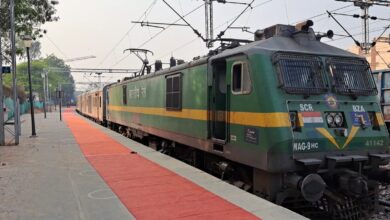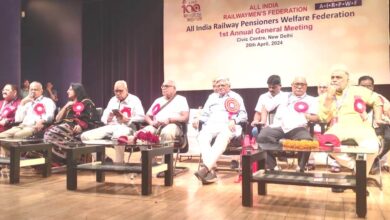Prime Minister Narendra Modi to Unveil Major Infrastructural Milestones: Eastern and Western Dedicated Freight Corridors to Transform India’s Logistics Landscape

In a monumental stride towards bolstering India’s logistics infrastructure, Prime Minister Narendra Modi is set to inaugurate key segments of the Eastern and Western Dedicated Freight Corridors (EDFC and WDFC) on March 12, 2024. These initiatives mark a significant leap forward in the country’s quest to revolutionize freight transportation and reduce logistical costs.
Eastern Dedicated Freight Corridor (EDFC): Transforming Connectivity Across Northern India
The highlight of the inauguration is the unveiling of the 401-kilometer-long New Khurja Junction to Sanhewal Section of the EDFC, constructed at a cost of Rs 11,859 crore. This stretch traverses through Uttar Pradesh, Haryana, and Punjab, connecting major agricultural and industrial hubs across 12 districts. With a maximum train speed of 100 kmph, the transit time for coal transportation from Eastern India to regional power plants is slashed to less than 20 hours, significantly enhancing India’s power security while reducing coal inventory costs by 20-30%. Moreover, the corridor expedites the movement of essential commodities, fertilizers, and food grains between regions, fostering economic growth and development.
Western Dedicated Freight Corridor (WDFC): Catalyzing Trade and Commerce
Simultaneously, Prime Minister Modi will inaugurate the 244-kilometer-long New Makarpura Junction to New Gholvad section of the WDFC in Gujarat, constructed at a cost of Rs 13,363 crore. This vital link connects five districts—Vadodara, Bharuch, Surat, Navsari, and Valsad—facilitating the swift transportation of perishable goods such as milk, vegetables, fruits, and farm products. By enhancing connectivity and reducing transit times, this section not only minimizes the risk of product damage but also boosts income for farmers and entrepreneurs. Additionally, it streamlines the movement of goods from landlocked states in the North to Western India’s ports, augmenting the country’s export-import (EXIM) capabilities.
State-of-the-Art Operation Control Centre (OCC) in Ahmedabad: Pioneering Freight Management
Further underscoring India’s commitment to modernizing its logistics infrastructure, Prime Minister Modi will dedicate the state-of-the-art Operation Control Centre (OCC) for the WDFC in Ahmedabad, Gujarat. Built at a cost of Rs 280 crore, this command center serves as the nerve center for the 1506-kilometer-long Western Dedicated Freight Corridor. Equipped with cutting-edge technologies including the Integrated Train Management System (TMS), Dedicated Freight Information System (DFIS), and Supervisor Control and Data Acquisition (SCADA) system, the OCC ensures real-time monitoring, control, and efficient planning of freight train operations, heralding a new era of efficiency and reliability in freight management.
DFCCIL & Vision for Viksit Bharat: Pioneering a Logistics Revolution
These monumental achievements align with the government’s vision of transforming India into a global economic powerhouse. With the goal of achieving a GDP of USD 5 trillion and becoming a ‘developed country’ by 2047, India aims to reduce its logistics costs to less than 10% of GDP, as per the National Logistics Policy. The ambitious Gatishakti National Master Plan envisages the creation of a robust logistics ecosystem, with Dedicated Freight Corridors playing a pivotal role in realizing these objectives. By increasing the share of railways in freight transportation to above 40%, these corridors offer an environmentally friendly and cost-effective mode of transportation, driving economic growth and sustainability.
DFC: A Paradigm Shift in Freight Transportation
The Dedicated Freight Corridors encompass two critical arteries—Eastern DFC spanning 1337 kilometers and Western DFC covering 1506 kilometers. These corridors, with their nerve centers at state-of-the-art Operational Control Centers in Prayagraj and Ahmedabad respectively, aim to create world-class rail infrastructure, facilitating Higher, Longer, Heavier, and Faster trains. By reducing the unit cost of logistics and promoting modal transfer from roads to railways, the DFCs optimize freight movement, enhance efficiency, and stimulate economic growth.
Transformative Impact and Future Prospects
The completion of the EDFC and significant progress on the WDFC have already begun reshaping India’s logistics landscape. With EDFC achieving 100% completion and daily operations witnessing over 150 trains running at an average speed of 50-60 kmph, and WDFC nearing 81% completion with over 100 trains operating daily at an average speed of 50-55 kmph, these corridors are witnessing unprecedented efficiency and throughput. By unlocking the potential for faster, safer, and more cost-effective freight transportation, the DFCs are poised to catalyze economic growth, foster trade and commerce, and create new avenues of employment generation across the country.
Conclusion: Pioneering a New Era in Freight Transportation
As Prime Minister Narendra Modi unveils these transformative infrastructural milestones, India embarks on a journey towards a more efficient, sustainable, and resilient logistics ecosystem. The Dedicated Freight Corridors represent not only a paradigm shift in freight transportation but also a testament to India’s commitment to fostering economic growth, enhancing connectivity, and realizing its vision of a ‘Viksit Bharat’—a developed and prosperous India for all.




